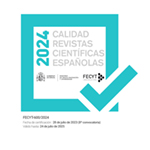Dangers, solutions and justifications in the art of translation in the 18th century. Ignacio García Malo’s case
Abstract
The art of translation at the end of the 18th century generated quite a lot of suspicions among the most erudite layers of the society, particularly because of the frequent mistakes made in the linguistic field. For that reason, a writer who is very conscientious regarding his literary reputation, as was the case with Ignacio García Malo, will try to dissociate himself from that plague of incompetent corrupters of language, by proclaiming that his translations, which are a result of the qualification and the effort devoted to them, will be useful for the nation. However, we are not very convinced that he will put into practice the orthodoxy he boasts about the use of neologisms, especially as regards to French expressions and terms.Downloads
Article download
License
In order to support the global exchange of knowledge, the journal Estudios de Traducción is allowing unrestricted access to its content as from its publication in this electronic edition, and as such it is an open-access journal. The originals published in this journal are the property of the Complutense University of Madrid and any reproduction thereof in full or in part must cite the source. All content is distributed under a Creative Commons Attribution 4.0 use and distribution licence (CC BY 4.0). This circumstance must be expressly stated in these terms where necessary. You can view the summary and the complete legal text of the licence.









